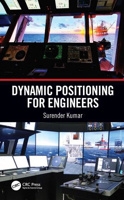Published: October 2020
Dynamic Positioning for Engineers enables the reader to acquire the basic knowledge of the concepts and understanding of the dynamic positioning (DP) system from the systems perspective. This book illustrates the system, subsystems and components of the DP system to better tackle maintenance, problems and breakdowns, leading to an increased mean time between failures and effective fault finding on dynamic positioning DP-related equipment. Overall, this text will help professionals reduce downtime and higher repair costs. Aimed at onboard electrical engineers, engine room watch officers, chief engineers, DP professionals onboard, in onshore officers and those taking DP training courses, this book:
- Explains automation and its application in the DP system
- Describes environmental sensors and position reference sensors as important inputs to the DP system
- Includes chapters on power management and thrusters
- Aids engineers in maintaining a the DP system in good operational condition
Table of Contents
1. Introduction to Offshore
1.1. Drilling operations
1.2. Offshore structures
2. Historical background to development of Dynamic Positioning
2.1. Background and History of Dynamic Positioning Development
2.2. Developments
3. The Seven Components of DP System
3.1. Sub Systems and grouping
4. Six Degrees of Freedom – Basics of Dynamic Positioning
4.1. Ship’s movements
4.2. Movements Controlled and Monitored By DP
4.3. Mathematical Model
4.4. DP System
4.5. Advantages and Disadvantages of the DP System
4.6. Wind Feed Forward
4.7. Excursion or feedback of ships position
4.8. Current Feedback
4.9. Thruster Allocation Logic
4.10. Quick-current or fast learn
4.11. Kalman Filter
4.12. DP Operational Modes
5. Different Types of DP Vessels and their applications
5.1. Types and applications of DP enabled ships
5.2. Other Specialised Vessels
5.3. DP Advantages
6. DP Class / Equipment class (IMO-MSC 645/1580)
6.1. Introduction to DP Class
6.2. Major Class DP Notations
6.3. DP Vessel Class / IMO DP Class
6.4. Basic/hardwired DP System
6.5. Integrated/networked DP System
7. Basics of Electrical Propulsion and Thruster Types
7.1. Basics of Electrical Propulsion and Thruster Types
7.2. Diesel Electric Propulsion for DP Vessels
7.3. Thruster Response and Accuracy
7.4. Thruster Modes
7.5. Different types of propulsion units and thrusters
7.6. Comparison of Diesel-mechanical (DM), Diesel-electric (DE) and Hybrid
7.7. Precautions while working of CPP Drives
8. Thruster Controls and Automation of thrusters in DP
8.1. Introduction
8.2. Thruster Response and Accuracy
8.3. Thruster control and automation
8.4. Thruster Monitoring and Alarm
9. Power Management System
9.1. Introduction
9.2. Estimation of DP Power requirements
9.3. Power Management System
9.4. Power Blackouts – Causes
9.5. Power Blackout avoidance strategies
9.6. Functions of PMS
9.7. Load Sharing
9.8. Uninterrupted Power Supply
10. Harmonics in Power Syatem
10.1. Introduction
10.2. Base frequency
10.3. What is “Triplen” in Harmonics
10.4. Effects of Harmonics
10.5. Finding and measuring harmonics in power system
10.6. Correcting harmonics in power system
11. Introduction to Environmental Sensors
11.1. Introduction
11.2. Sensor Redundancy
11.3. VRU /VRS/MRU
11.4. Gyro Compass in a DP System
11.5. Wind Sensors
12. Introduction to Position Reference Sensors
12.1. Introduction
12.2. Basic working principles of the PRS/PME
12.3. Radar/Microwave based systems
12.4. LASER
12.5. Acoustics
12.6. Mechanical PRS - Taut Wire Position Reference System
12.7. Frequency Modulated Continuous Wave (FMCW) Radars
12.8 RangeGuard
13. Handling of Position Reference Sensors & Various Tests on PRS
13.1. Introduction
13.2. Various Tests on PRS
13.3. Processing of data from PRS/PME
13.4. Conclusion
14. Architecture of DP System
14.1. Introduction
14.2. System architecture for a DP Class 1 System
14.3. System architecture for a DP Class 2 System
14.4. System architecture for a DP Class 3 System
15. Basics of Networking in DP Systems
15.1. Introduction to Communications in DP System
15.2. Networking in DP System
15.3. Basics of networking
15.4. Common troubles in networking and their remedies
15.5. General Troubleshooting Steps for Network problems
16. Types of Signals used in DP Automation
16.1. Introduction - Different types of signals in marine automation
16.2. Serial Line Interface
16.3. NMEA 0183
16.4. Position Reference System (PRS) Interfaces
16.5. Signals used for Environmental Sensor Interface
16.6. Signals for Thruster Interfaces
16.7. Signals for Power Plant Interfaces
16.8. Other Interfaces
17. Consequence Analysis, Capability Plot, Foot prints and Motion Prediction
17.1. Introduction -Consequence Analysis
17.2. Capability Plot
17.3. Foot Prints
17.4. Motion Prediction
18. DP Trials & Documentation
18.1. Introduction
18.2. IMCA Guidance on DP Trials
18.3. DP FMEA/FMECA Proving Trials
18.4. DP Vendor Reports
18.5. DP Correspondence/communication
18.6. DP Fault Log
18.7. DP Incident Log
18.8. Operational Issues
19. Circuit Tracing & Fault Finding on DP
19.1. Introduction
19.2. How to Read ingle Line Diagrams/Schematics
19.3. Fault Finding Procedures
19.4. Software fault and related issues
20. Roles and Responsibilities
20.1. Introduction
20.2. Captain/Master
20.3. SDPO/DPO
20.4. Chief Engineer
20.5. Engineer of the Watch
20.6. Electrical Technical Officer (ETO)
21. Glossary
22. References




























